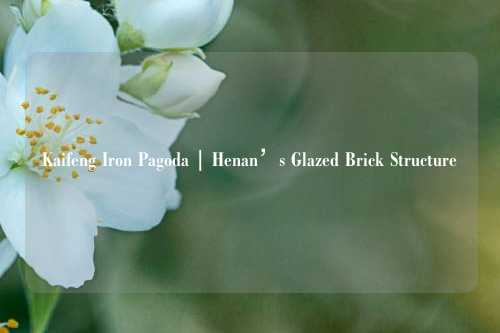Kaifeng Iron Pagoda | Henan’s Glazed Brick Structure
The History and Cultural Significance of the Kaifeng Iron Pagoda
The Kaifeng Iron Pagoda, located in the city of Kaifeng in Henan Province, stands as a remarkable symbol of Chinese architectural ingenuity and Buddhist devotion. Originally constructed during the Song Dynasty (960-1279), this pagoda has withstood centuries of natural disasters and human interventions, making it one of the most enduring and iconic structures in Chinese history. The pagoda’s historical and cultural significance goes beyond its architectural features, serving as a symbol of the prosperous Song Dynasty and the religious practices that influenced the region.
The pagoda was constructed in 1049 under the reign of Emperor Renzong of the Northern Song Dynasty. It was built as part of a larger Buddhist temple complex to house sacred relics and to promote the Buddhist faith. The pagoda’s name, “Iron Pagoda,” comes from the unique glazed brick structure that gives the pagoda its striking appearance and helps protect it from the ravages of time. Despite numerous earthquakes, fires, and other natural disasters that have impacted the region, the Kaifeng Iron Pagoda has remained remarkably intact, a testament to the skilled craftsmanship and lasting cultural values of the time.

Architectural Features: A Blend of Strength and Beauty
The most striking aspect of the Kaifeng Iron Pagoda is its architecture. Rising 55 meters high, it was one of the tallest structures in China when it was built. The pagoda is made from a combination of brick and iron, which provides it with both structural strength and aesthetic beauty. Its unique design combines traditional Chinese pagoda features, such as tiered eaves and a multi-level structure, with the innovative use of glazed bricks and intricate carvings. The glazed bricks, which were fired at a high temperature, give the pagoda its gleaming surface and offer protection against the elements.
The pagoda’s form consists of 13 stories, each adorned with intricate carvings of Buddhist motifs, religious figures, and scenes from Chinese mythology. These carvings reflect the religious and cultural significance of the structure, offering insight into the beliefs and practices of the Song Dynasty. The vertical design of the pagoda symbolizes the spiritual ascent toward enlightenment, with each level representing a step closer to achieving Buddhist nirvana. The use of iron in the structure also reinforces the idea of strength, endurance, and resilience, which are central to Buddhist philosophy.
The Role of the Kaifeng Iron Pagoda in Buddhism
The Kaifeng Iron Pagoda was originally built to house Buddhist relics and to provide a place for meditation and prayer. As a key site for Buddhist worship, the pagoda played a significant role in promoting the teachings of Buddhism during the Song Dynasty. The pagoda was also used for religious ceremonies, with Buddhist monks performing rituals and offering prayers to the Buddha. Over time, the pagoda became a symbol of Buddhist devotion and a pilgrimage site for those seeking spiritual enlightenment.
In addition to its religious function, the pagoda’s architecture served as a visual representation of the Buddhist teachings. The multi-tiered structure, with its upward progression, was meant to symbolize the journey of the soul toward enlightenment. The carvings and inscriptions found on the pagoda’s bricks reflect the Buddhist worldview, with themes of compassion, wisdom, and enlightenment.
Despite the decline of Buddhism’s influence in China over the centuries, the Kaifeng Iron Pagoda remains a key spiritual landmark. It continues to attract Buddhist pilgrims and tourists from around the world, who visit to admire its beauty and to reflect on the enduring legacy of Chinese Buddhist architecture.
The Glazed Brick Technique: A Masterclass in Ancient Engineering
One of the most distinctive features of the Kaifeng Iron Pagoda is its use of glazed bricks, a technique that was advanced for its time. The bricks were made from high-quality clay, which was then glazed with a protective coating before being fired in kilns. This process not only made the bricks more durable but also gave the pagoda its unique glossy appearance.
The glazed brick technique allowed for the creation of intricate designs and patterns on the surface of the pagoda, making it both structurally sound and visually striking. The bricks were carefully arranged in patterns to form decorative motifs and religious symbols, which are still visible today. The combination of strong materials and detailed craftsmanship has helped the pagoda endure centuries of weathering, including harsh winds, earthquakes, and other natural disasters.
In addition to the practical benefits of glazed bricks, the technique also reflects the advanced engineering knowledge of the Song Dynasty. The use of fired clay bricks, which were more durable than wood or other materials, was a significant innovation that allowed for the construction of taller and more intricate buildings. The Kaifeng Iron Pagoda is a testament to the technological achievements of its time, combining artistic beauty with engineering precision.
Preserving the Kaifeng Iron Pagoda: A Cultural Treasure
Over the centuries, the Kaifeng Iron Pagoda has faced numerous challenges, including natural disasters such as earthquakes and floods, as well as the effects of time and neglect. Despite these challenges, the pagoda has managed to withstand the test of time, thanks to efforts to preserve and protect it. In recent years, there have been significant restoration efforts aimed at maintaining the structure and ensuring that it remains standing for future generations.
In the 20th century, the Kaifeng Iron Pagoda was recognized as an important cultural and historical landmark. It was declared a national cultural heritage site by the Chinese government and has been carefully maintained and preserved as part of the country’s rich architectural heritage. In 1996, the pagoda was included on the list of cultural heritage sites under the jurisdiction of the State Council, making it a priority for preservation.
As part of the preservation efforts, experts have worked to reinforce the pagoda’s foundation and repair any damage caused by earthquakes and other environmental factors. The use of modern technology, including structural analysis and material science, has helped guide the restoration process, ensuring that the pagoda’s historical integrity is maintained while also ensuring its safety.
The Kaifeng Iron Pagoda and Its Cultural Legacy
Beyond its architectural and religious significance, the Kaifeng Iron Pagoda also holds deep cultural meaning for the people of Kaifeng and the broader Henan Province. As a symbol of the Song Dynasty’s prosperity and technological advancement, the pagoda reflects the cultural values of the time, including the importance of Buddhism, education, and artistic expression. The pagoda’s survival through the centuries has made it a cherished part of the local identity, and it continues to be a source of pride for the people of Kaifeng.
The pagoda is also an important symbol of the enduring relationship between the people of China and their history. As visitors come to admire its beauty and learn about its significance, the Kaifeng Iron Pagoda serves as a reminder of the country’s rich cultural heritage and the ongoing efforts to preserve and celebrate it. The pagoda’s legacy extends beyond its physical structure, inspiring future generations to appreciate the values of craftsmanship, dedication, and resilience.
The Kaifeng Iron Pagoda as a Tourist Destination
Today, the Kaifeng Iron Pagoda attracts thousands of visitors each year, drawn by its historical significance, architectural beauty, and spiritual importance. The pagoda is located within the confines of a park that features a range of other attractions, including gardens, temples, and museums that further enhance the visitor experience. The park offers a peaceful and reflective setting, where tourists can wander among ancient trees, observe traditional Chinese landscaping, and appreciate the serene atmosphere that surrounds the pagoda.
Visitors can enter the pagoda itself and climb to the top for panoramic views of the surrounding city and countryside. From this vantage point, it is easy to appreciate the strategic placement of the pagoda and its role as a visual landmark within the region. The surrounding area also contains several historical sites and cultural attractions that complement the experience of visiting the Iron Pagoda, making Kaifeng a must-see destination for those interested in Chinese history and culture.
In addition to its role as a tourist attraction, the Kaifeng Iron Pagoda also hosts cultural and religious events throughout the year, drawing visitors and pilgrims who come to pay their respects and participate in ceremonies. The site is especially popular during Buddhist festivals, when the pagoda is decorated with lanterns and offerings, and the surrounding area is filled with the sounds of prayers and music.
The Future of the Kaifeng Iron Pagoda
The future of the Kaifeng Iron Pagoda looks promising, with continued efforts to preserve and protect the structure ensuring that it remains a cherished landmark for years to come. As a symbol of Chinese history, architecture, and spirituality, the pagoda continues to captivate the imagination of visitors and serves as a reminder of the achievements of past generations. Its enduring beauty and cultural significance ensure that it will remain a vital part of China’s architectural heritage, inspiring future generations to appreciate and protect the treasures of their history.
















